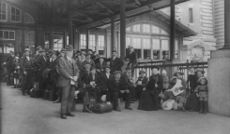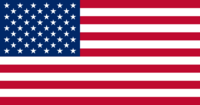United States of America
The United States of America, also known as the United States or America, is a nation located in North America, bordering both the North Atlantic Ocean and the North Pacific Ocean, between Canada and Mexico. The current head of state is President George W. Bush, serving from 2001 and will step down in 2009.
Geography
Climate
The climate is diverse in the United States, but many parts have a continental climate, often with hot summers and great variations in temperature during a year.
The west coast has a maritime climate, with relatively mild winters. There is however a big difference between the northern and southern parts of the west cost. The northern parts receive a lot of precipitation, especially during the fall. The southern and central parts of California have a typical Mediterranean climate, with very little precipitation and sun most of the year. One of the warmest areas of the world, Death Valley, is located in Southern California.
East of the Rocky Mountains are the Great Plains. This area consists of large steppes, having a unique climate. Moist winds from the Gulf of Mexico meet cold wind from the north, which leads to a lot of changing weather. The Great Plains are known for their tornadoes, and for snow and hail storms. The Midwest is known for short springs and falls, and often long winters.
The climate is mostly warm in the southern states along the Gulf, and there is hardly any real winter. The south often sees hurricanes in the fall, causing great damage.
The climate is more varied on the east coast and in the Appalachian Mountains, but a common denominator is that these areas often receive lot of precipitation. The climate of the east coast is to a lesser degree than he west coast affected by the ocean, so that is has a typical continental climate. The northeastern parts of the United States have a lot of snow in the winter, including the coastal areas.
History
Two million British settlers in 13 colonies (along with German and other immigrants, and African slaves) comprised the Thirteen Colonies of 1775. Angered by deprivation of their historic rights by Britain, they revolted in 1775, and declared independence on July 4, 1776 as the new nation, The United States of America. Thomas Jefferson wrote the Declaration of Independence, which expressed the nation's commitment to republican ideals. The war for independence against Britain, in league with France and others, was a success. George Washington, who led the military effort, chaired the Constitutional Convention of 1787, which divided powers between the states and national government, and divided powers in the latter among legislative (Congress), executive (President) and judicial (Supreme Court) branches. During the 19th and 20th centuries, 37 new states were added to the original 13 as the nation expanded across the North American continent. The two most traumatic experiences in the nation's history were the Civil War (1861-65) and the Great Depression of the 1930s. Buoyed by Allied victories in World Wars I and II and the end of the Cold War in 1991, the U.S. remains the world's most powerful nation-state. The economy is marked by steady growth, low unemployment and inflation, rapid advances in technology, and a very wide range of incomes, compared to other nation-states.[1][2]
Economy
The economy of the United States is based upon capitalism, with elements of a mixed economy. The U.S. is the world's economical powerhouse, and the standard of living is mostly high. The median income is $46,326 per household. The wealth is somewhat unevenly distributed; the top 20% have a household median income of $91,705, the lowest 20% have $19,178.
Private enterprises account for the biggest part of the U.S. Gross Domestic Product, but the public sector is also substantial, consisting of 35% of the GDP. Government regulations are not as extensive as in many other western countries. The labor market is flexible, and social welfare services are more limited than in Europe. Social spending is increasing, and the cost of federal programs such as Medicare and Medicaid is growing.
The central bank of the United States is the Federal Reserve System. The Federal Reserve is independent from the government, and Congress does not interfere with its policies.
Demographics

The population of the United States reached 300 million in 2006. The population is highly heterogeneous, and consists of many ethnic groups. The majority of Americans are whites of European descent. The largest group is German-Americans; with Irish-Americans, English-Americans coming next. The largest minority groups in the United States is African-Americans.
The current demographic trend is that the Hispanic population is growing, mostly because of immigration from Mexico and other Latin American countries.
Language
English is the de facto national language, even though there is no official language at the federal level. Applicants for U.S. citizenship have to pass an English literacy test.
About 82% of the population speak nothing but English at home. The second most commons language is Spanish. 29 states have made English their official language. Three states have other additional languages used by the state governments; Hawaiian in Hawaii, French in Louisiana, and Spanish in New Mexico.
Religion

Religion is an integrated part in American daily life, and society is not as secularized as in many other developed nations. Six out of ten Americans feel that their faith plays a very important role in their lives.[3]
The U.S. Census Bureau does not audit the religious beliefs of the American population; the figures for religious beliefs in the United States are therefore somewhat uncertain. The CIA World Factbook estimate that 90% of Americans are believers. Christianity is the largest religion, with protestants making the biggest group (52%). 24% of the population are catholics.
It is a strict separation of church and state, guaranteed by the First Amendment to the United States Constitution. Christian symbolism is nevertheless widely used; The Pledge of Allegiance states that the United States is "one Nation under God." The national motto of the United States is "In God We Trust."
Religion is an important part of American politics, and the personal beliefs of candidates are often used in political campaigns. All presidents of the United States have had a protestant background, with the exception of John F. Kennedy who was catholic. Christians in the United States tend to lean towards the U.S. Republican Party, while democrats often are more secular.
See also
References
- ↑ CIA's World Factbook - Distribution of family income
- ↑ [1]
- ↑ Among Wealthy Nations, U.S. Stands Alone in its Embrace of Religion. Pew Global Attitudes Project. Retrieved on July 16, 2007.
